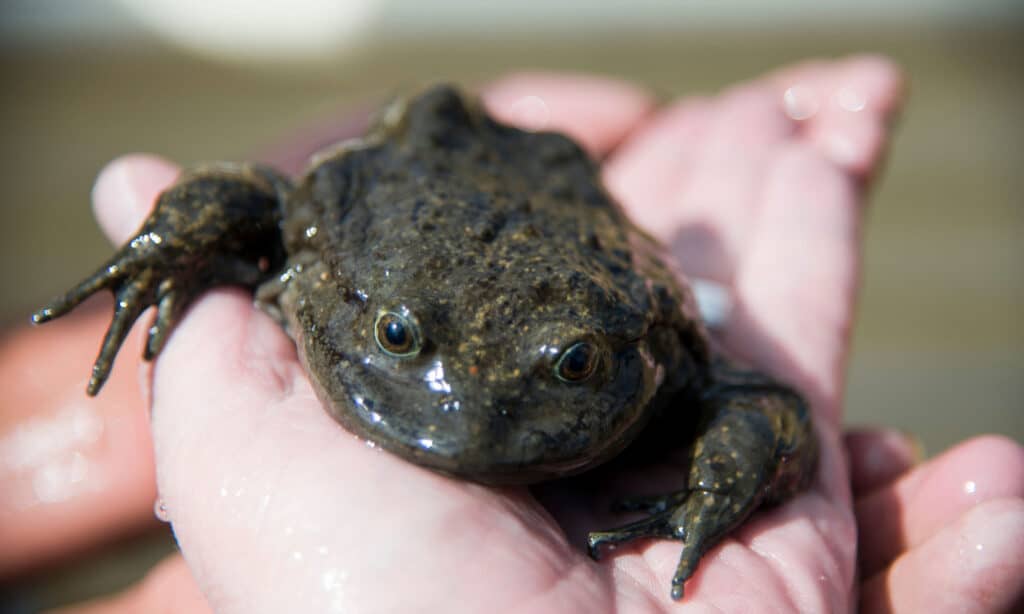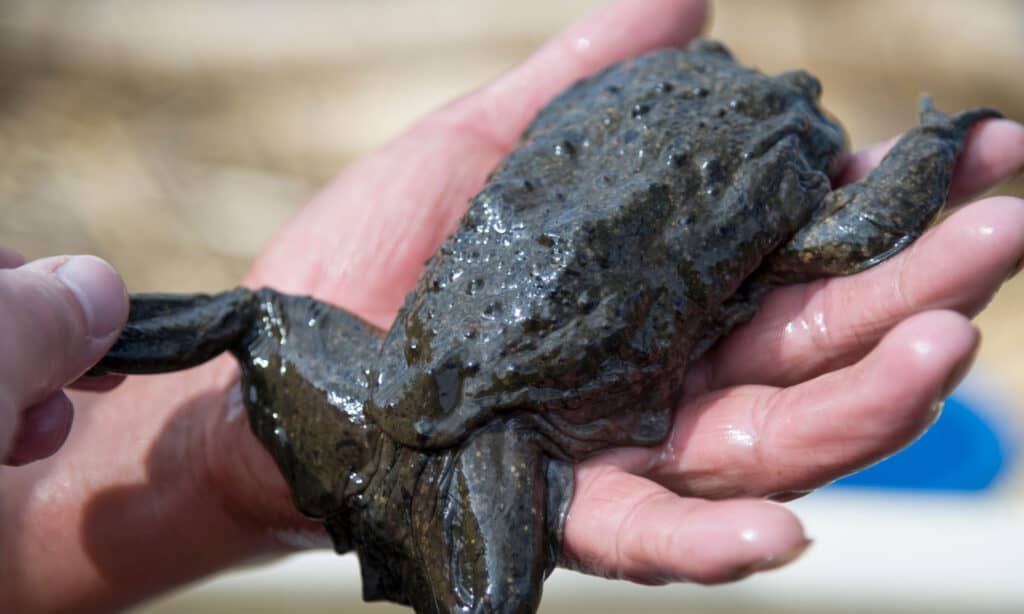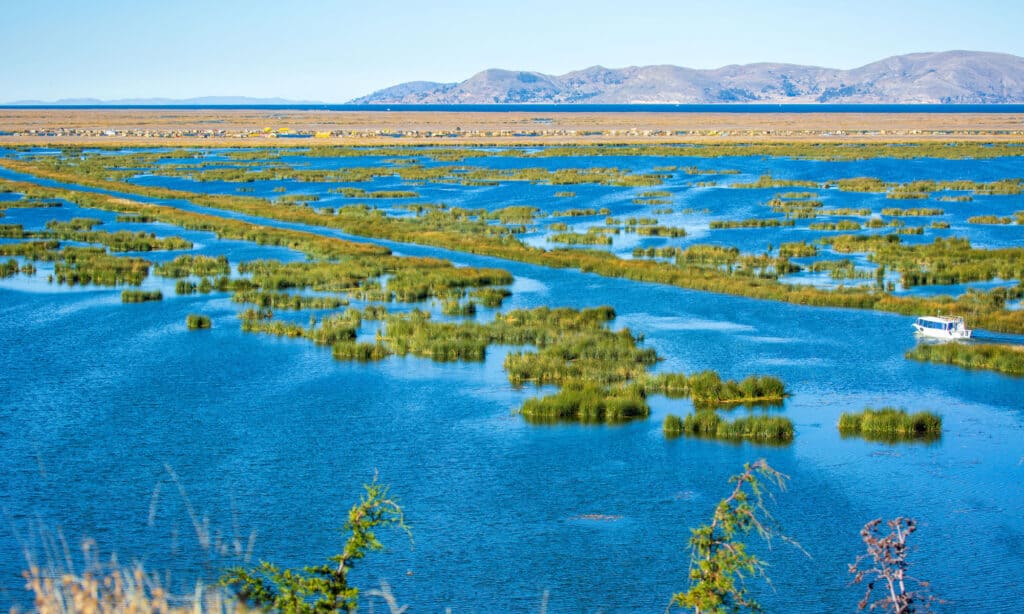The giant Titicaca water frog is the stuff of legend. Spending its whole life in the depths of Lake Titicaca, this species has made headlines in recent years for both its abnormal appearance and vulnerability to extinction.
Titicaca water frogs are found nowhere else on Earth, and, for various reasons, they’re in extreme peril of disappearing altogether. Giant water frogs are unique among amphibians in more ways than one, and losing them would have disastrous consequences for the local ecology.
That’s why we’re here to discuss not only the incredible size of the Titicaca water frog but the biggest threats currently facing the species. We’ll learn about the distinct look of this frog, as well as how large it can grow.
Then, we’ll take a look at what Titicaca water frogs spend their days doing and where in the world they’re found. After that, we’ll learn about what these frogs eat and what the primary threats to their survival are. Finally, we’ll go over all the ways that both scientists and locals are working to conserve this species.
Titicaca Water Frog: The Facts
The Lake Titicaca water frog (Telmatobius culeus) is one of the largest aquatic frogs on Earth—it’s also one of the rarest. Harvested and sold for the purportedly aphrodisiac qualities of their meat, these massive frogs face threats from poachers, pollution, and introduced trout. Scientists are working with locals to educate and protect the lake’s giant water frogs, but they’re still in peril of extinction.
Appearance

The most distinguishing feature of the Titicaca water frog is its baggy skin.
©Andreas Wolochow/Shutterstock.com
The most distinguishing feature of the Titicaca water frog is its baggy skin. Like all frogs, these giants have four legs, webbed toes, large mouths, and round bodies. Unlike other frog species, their bodies are covered in folds of thin, loose skin. But the skin isn’t just for show—it’s actually for breathing. The lake’s water frogs are entirely aquatic, which means they spend their entire lives underwater, breathing through their loose skin.
The next most distinguishing feature of the giant water frog is its eyes. They’re large, forward-facing, yellow, and wide open. Coupled with their wide mouths and small nasal openings, the eyes give giant water frogs a comical appearance. Their color ranges from tan or brown to gray, with some darker mottling. Their bellies are pale, and their legs often have faint stripes.
Size

The giant frogs of Lake Titicaca are enormous, but they’re not the largest frogs in the world.
©Andreas Wolochow/Shutterstock.com
The giant Titicaca water frog is no small fry. Adults measure up to eight inches long in the body, with legs up to 16 inches long. Fully extended, they can measure nearly two feet long and weigh over two pounds. However, the vast majority of these frogs never reach these gargantuan sizes. Instead, they top out at around six inches long in the body and weigh around one pound.
Of course, like all frogs, Titicaca water frogs start out life as eggs. Females can lay up to 500 eggs per gestation. After a couple of weeks, tiny tadpoles emerge from the eggs. These tadpoles stay in the shallow, coastal waters of Lake Titicaca for up to three years until they’re big enough to brave the deep lake waters.
Behavior
Not much is known about the day-to-day behavior of the giant Titicaca water frog. This is largely due to the fact that adults spend most of their time at the bottom of the lake, far from the eyes of humans. Scientists believe, however, that these frogs are largely nocturnal. And, like all frogs, they’re ambush predators that hunt by leaping forward on long legs and consuming their prey in one bite.
Range and Habitat

The Titicaca water frog is endemic only to Lake Titicaca.
©iStock.com/Joanne Wastchak
High in the Peruvian Andes, there is a lake known as Lake Titicaca. This is the only place in the world where you can find Titicaca water frogs—that’s part of what makes them so special. Within the lake, tadpoles and froglets stick to the shallow coastal fringes, while adults dive deeper. Giant water frogs live in sandy, muddy silt among rocks and aquatic plants.
Diet
Lake Titicaca water frogs eat freshwater shrimp, insects, tadpoles, fish, and snails. Like all frog species, they’re opportunistic hunters and will eat just about anything they can fit into their mouths. This includes smaller members of their own species. Tadpoles are especially vulnerable to predation by not only adult Titicaca water frogs but introduced trout.
Threats to the Titicaca Water Frog

One of the biggest threats to the Titicaca water frog is the pollution of Lake Titicaca.
©iStock.com/StreetFlash
Lake Titicaca water frogs were once extremely common in the lake. But decades of poaching, pollution, and predation by introduced species have decimated the native population. For years, locals have captured and sold these frogs as the main ingredient for the traditional medicinal drink known as frog juice. This drink consists of raw, blended giant water frog, along with maca root, and perhaps honey. It’s reputed to cure just about any ailment the buyer might think of.
Additionally, Titicaca water frog populations have been severely impacted by introduced trout (which eat the tadpoles), climate change, and lake pollution.
Conservation
In the past ten years, scientists from around the world have rallied to save the Titicaca water frog. To start, scientists opened dialogues with local peoples to educate them about the frogs’ declining population and why they’re important to the ecology of Lake Titicaca.
Today, frogs are still killed and sold, but in lesser numbers. In fact, there’s even a group of local women who have stopped selling frogs and started selling frog-themed handicrafts. The women don’t make much money from the crafts, but to them, preserving the giant frogs that their families have known for generations is a worthy endeavor.
The photo featured at the top of this post is © Andreas Wolochow/Shutterstock.com
Thank you for reading! Have some feedback for us? Contact the AZ Animals editorial team.






